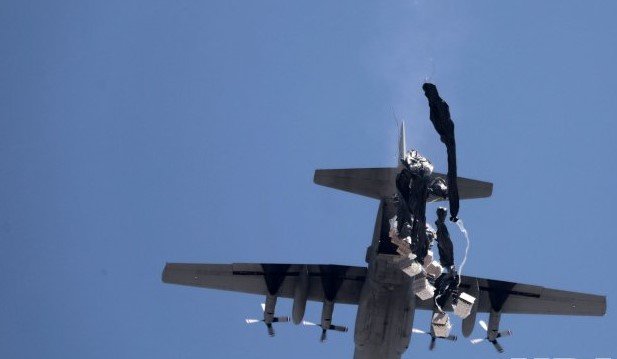Over 300 tonnes of aid dropped as Kingdom leads joint air operations with UAE, Germany, Canada and others
The Jordanian military is ramping up its humanitarian campaign for Gaza, coordinating with international allies to deliver critical food and supplies by air. The operations come as the war’s humanitarian toll grows heavier by the day — and diplomatic efforts stall yet again.
In just the last 12 hours, the Jordan Armed Forces carried out seven more airdrops, teaming up with five foreign nations. It’s part of a larger mission that’s already seen hundreds of flights and more than 300 tonnes of aid dropped into the besieged Palestinian enclave.
Coordinated Missions, Quiet Precision
Monday’s flights involved seven aircraft — two from Jordan’s own Royal Air Force, and five contributed by the UAE, Germany, France, Belgium, and Canada.
The packages? Food, medicine, and relief supplies. The goal? To reach desperate families trapped by closed land crossings and ongoing military operations.
The figure speaks volumes: 45 tonnes of aid delivered in a single day.
Even more striking is the total since the latest round of operations began two weeks ago:
-
139 airdrops by Jordan alone.
-
289 total airdrops in collaboration with international partners.
-
305 tonnes of aid delivered since mid-July.
It’s not flashy. It’s not loud. But it’s lifesaving.

A Warzone That Keeps Getting Harder to Reach
Getting aid into Gaza hasn’t just been difficult — at times, it’s felt impossible. Land borders remain severely restricted. Convoys face delays, inspections, and sometimes outright rejection.
So Jordan turned to the sky. And the world followed.
While airdrops can’t meet the full demand on the ground, they bypass bottlenecks and reach areas no truck currently can. For Gazans, especially those in the north and along damaged coastal areas, it’s become a rare and vital lifeline.
One sentence here: When roads are closed, parachutes take their place.
Global Coalition Behind Jordan’s Push
The scale and reach of Jordan’s mission wouldn’t be possible without international support. Over the last few months, the Kingdom has quietly built a network of coordination with global powers — both Western and Arab.
Monday’s operation is a snapshot of that collaboration.
Here’s a quick overview of who’s been involved recently:
| Country | Aircraft Type Used | Aid Contribution Focus |
|---|---|---|
| Jordan | C-130 Transport | General supplies, food |
| UAE | Multi-role cargo | Medical and food kits |
| Germany | Military cargo | Infant nutrition, shelter supplies |
| France | Tactical aircraft | Emergency rations |
| Belgium | Support aircraft | Medical kits, hygiene |
| Canada | Strategic lift | Field rations, blankets |
For Jordan, it’s about more than just aid. It’s about leadership — humanitarian, moral, and regional.
Why Jordan Can’t Afford to Stay on the Sidelines
Jordan doesn’t share a border with Gaza. But politically, culturally, and historically, it’s deeply tied to the Palestinian cause.
King Abdullah II has repeatedly called for a ceasefire and emphasized Jordan’s role as a humanitarian corridor. Earlier this year, Amman opened its airspace for other countries to conduct relief missions into Gaza.
The Kingdom’s credibility in the region is tightly bound to how it responds in moments like this.
Abdul Razzaq Arabiyat, head of Jordan’s tourism board, recently said: “Even far from the front lines, we feel Gaza every day.” His words were about economic impact. But they speak just as loudly on the humanitarian front.
One small paragraph: Silence is not an option.
The Numbers Keep Climbing, But So Does the Need
Despite hundreds of airdrops, the need inside Gaza is growing, not shrinking.
With entire neighborhoods flattened and electricity supplies intermittent, many Gazans are living in tents, schools, or makeshift shelters. Food insecurity is worsening, and access to clean water remains limited.
Jordan’s airdrops alone can’t solve that. But they help. In small, consistent waves.
Here’s what the humanitarian deliveries since mid-July look like by the numbers:
-
305 tonnes of humanitarian cargo dropped.
-
More than 400 total airdrops (solo and joint missions combined).
-
Roughly 20 nations have contributed logistics or aircraft support since January.
It’s a global mission, with Jordan as its regional backbone.
Diplomacy on Hold, But Aid Keeps Falling
While ceasefire talks continue to stall, and negotiations drag on in Qatar and Cairo, aid delivery has taken a more direct route: straight from the sky.
Jordan’s foreign ministry has remained vocal, urging for unfettered aid access and protection of civilians. But in the meantime, the military is doing the talking — with parachutes.
One senior defense official in Amman told state media: “Our role is not political in these drops. It’s human. We will keep flying for as long as it’s needed.”
